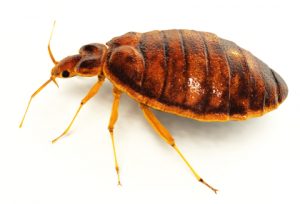The biggest pest problem threatening any populated area in recent years is the bed bug. Their population had declined steadily since the 1930s, to the point of near extinction a few years ago. Unfortunately, due to numerous circumstances, bed bugs have returned with a vengeance, and exist everywhere. Bed bugs have been with us a long time. In fact, the earliest use of the word “bug” was to describe this particular nasty little parasite.
Bed bugs are most unpleasant because they feed exclusively on blood, and while many species are far more attractive to them than we are, bed bugs are very good at infiltrating the homes of human hosts and setting up large colonies that feed on us and our pets.
These insects are reddish brown in color, oval in shape and look very similar to wood ticks. Like wood ticks, they feed off human blood and after eating swell up and become burgundy in color. Usually they can be found along seams in mattresses and cushions and will hide in tiny cracks and crevices. They are notably small – around 4-5mm for adults and less than 1.5mm in the nymph stage. They can live up to a year off one feeding and will often move to a more remote location where they can live and breed in darkness.
Bed bugs are equal opportunity parasites. There is no cause of an infestation other than the availability of food. Since they eat blood, a ready supply of human beings is all they need to motivate them to settle a new location. Bed bugs are no more likely to settle a dirty house than a clean one, and being victimized by these nasty little parasites should carry no social stigma. Bed bugs can be brought into a home in a variety of ways, commonly from transportation of furniture and clothing or “hitching a ride” on a pet or person who comes to visit.
Once they’re in a home, bed bugs cause misery. Their bites affect people differently – some people hardly notice, while others can blister and suffer painful reactions. Getting rid of a bed bug infestation is no simple matter, either. Most insecticides available to consumers are ineffective, and the bugs can live for months without feeding. Bed bugs live in a wide range of temperature conditions, reproduce quickly, and spread easily.
One thing is certain. If you have bed bugs, you want to be rid of them as soon as possible. Treating them yourself is nearly impossible, as consumer-grade pesticides are largely ineffective. You will need professional help.
That’s where Poulin’s Pest Control comes in. Our technicians are constantly taking new training and updating certifications in order to help rid our customers of their pest problems. We’ll get rid of your bed bugs, and help you keep them away.
Depending on the severity of the plight, many options are available. If you are fortunate to only find a few, maybe hitchhikers from a recent trip, you can wash infected items in soapy water at the hottest setting allowable for the fabric. Use a scrub brush on luggage and bags. Be sure to target pockets, seams and tight places where the bugs may hide.
If your problem is more widespread, you need to call in experts in pest control. Chemical treatments are available in which pesticides are used to kill the varying stages of bed bugs. For optimum effectiveness, consider bed bug heat treatments.

